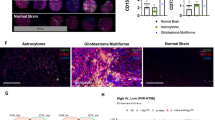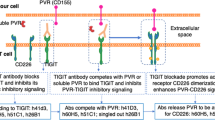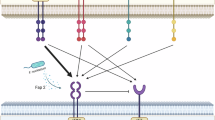Abstract
Activating and inhibitory receptors control natural killer (NK) cell activity. T-cell immunoglobulin and ITIM (immunoreceptor tyrosine-based inhibition motif) domain (TIGIT) was recently identified as a new inhibitory receptor on T and NK cells that suppressed their effector functions. TIGIT harbors the immunoreceptor tail tyrosine (ITT)-like and ITIM motifs in its cytoplasmic tail. However, how its ITT-like motif functions in TIGIT-mediated negative signaling is still unclear. Here, we show that TIGIT/PVR (poliovirus receptor) engagement disrupts granule polarization leading to loss of killing activity of NK cells. The ITT-like motif of TIGIT has a major role in its negative signaling. After TIGIT/PVR ligation, the ITT-like motif is phosphorylated at Tyr225 and binds to cytosolic adapter Grb2, which can recruit SHIP1 to prematurely terminate phosphatidylinositol 3-kinase (PI3K) and MAPK signaling, leading to downregulation of NK cell function. In support of this, Tyr225 or Asn227 mutation leads to restoration of TIGIT/PVR-mediated cytotoxicity, and SHIP1 silencing can dramatically abolish TIGIT/PVR-mediated killing inhibition.
Similar content being viewed by others
Log in or create a free account to read this content
Gain free access to this article, as well as selected content from this journal and more on nature.com
or
Abbreviations
- NK:
-
natural killer
- TIGIT:
-
T-cell immunoglobulin and ITIM domain
- PVR:
-
poliovirus receptor
- ITT:
-
immunoreceptor tail tyrosine
References
Vivier E, Tomasello E, Baratin M, Walzer T, Ugolini S . Functions of natural killer cells. Nat Immunol 2008; 9: 503–510.
Fan Z, Yu P, Wang Y, Fu ML, Liu W, Sun Y et al. NK-cell activation by LIGHT triggers tumor-specific CD8+ T-cell immunity to reject established tumors. Blood 2006; 107: 1342–1351.
Zhong C, Li C, Wang X, Toyoda T, Gao G, Fan Z . Granzyme K inhibits replication of influenza virus through cleaving the nuclear transport complex importin alpha1/beta dimer of infected host cells. Cell Death Differ 2011; 19: 882–890.
Tang H, Li C, Wang L, Zhang H, Fan Z . Granzyme H of cytotoxic lymphocytes is required for clearance of the hepatitis B virus through cleavage of the hepatitis B virus X protein. J Immunol 2012; 188: 824–831.
Orr MT, Lanier LL . Natural killer cell education and tolerance. Cell 2010; 142: 847–856.
Hoglund P, Brodin P . Current perspectives of natural killer cell education by MHC class I molecules. Nat Rev Immunol 2010; 10: 724–734.
Elliott JM, Yokoyama WM . Unifying concepts of MHC-dependent natural killer cell education. Trends Immunol 2011; 32: 364–372.
Watzl C, Long EO . Signal transduction during activation and inhibition of natural killer cells. Curr Protoc Immunol 2010 Chapter 11: unit 11.9B.
Kumar V, McNerney ME . A new self: MHC-class-I-independent natural-killer-cell self-tolerance. Nat Rev Immunol 2005; 5: 363–374.
Yu X, Harden K, Gonzalez LC, Francesco M, Chiang E, Irving B et al. The surface protein TIGIT suppresses T cell activation by promoting the generation of mature immunoregulatory dendritic cells. Nat Immunol 2009; 10: 48–57.
Stanietsky N, Simic H, Arapovic J, Toporik A, Levy O, Novik A et al. The interaction of TIGIT with PVR and PVRL2 inhibits human NK cell cytotoxicity. Proc Natl Acad Sci USA 2009; 106: 17858–17863.
Boles KS, Vermi W, Facchetti F, Fuchs A, Wilson TJ, Diacovo TG et al. A novel molecular interaction for the adhesion of follicular CD4 T cells to follicular DC. Eur J Immunol 2009; 39: 695–703.
Engels N, Wienands J . The signaling tool box for tyrosine-based costimulation of lymphocytes. Curr Opin Immunol 2011; 23: 324–329.
Joller N, Hafler JP, Brynedal B, Kassam N, Spoerl S, Levin SD et al. Cutting edge: TIGIT has T cell-intrinsic inhibitory functions. J Immunol 2011; 186: 1338–1342.
Levin SD, Taft DW, Brandt CS, Bucher C, Howard ED, Chadwick EM et al. Vstm3 is a member of the CD28 family and an important modulator of T-cell function. Eur J Immunol 2011; 41: 902–915.
Kerr WG, Colucci F . Inositol phospholipid signaling and the biology of natural killer cells. J Innate Immun 2011; 3: 249–257.
Neumann K, Oellerich T, Urlaub H, Wienands J . The B-lymphoid Grb2 interaction code. Immunol Rev 2009; 232: 135–149.
Engels N, Konig LM, Heemann C, Lutz J, Tsubata T, Griep S et al. Recruitment of the cytoplasmic adaptor Grb2 to surface IgG and IgE provides antigen receptor-intrinsic costimulation to class-switched B cells. Nat Immunol 2009; 10: 1018–1025.
Sakisaka T, Ikeda W, Ogita H, Fujita N, Takai Y . The roles of nectins in cell adhesions: cooperation with other cell adhesion molecules and growth factor receptors. Curr Opin Cell Biol 2007; 19: 593–602.
Takai Y, Miyoshi J, Ikeda W, Ogita H . Nectins and nectin-like molecules: roles in contact inhibition of cell movement and proliferation. Nat Rev Mol Cell Biol 2008; 9: 603–615.
Binstadt BA, Brumbaugh KM, Dick CJ, Scharenberg AM, Williams BL, Colonna M et al. Sequential involvement of Lck and SHP-1 with MHC-recognizing receptors on NK cells inhibits FcR-initiated tyrosine kinase activation. Immunity 1996; 5: 629–638.
Marti F, Xu CW, Selvakumar A, Brent R, Dupont B, King PD . LCK-phosphorylated human killer cell-inhibitory receptors recruit and activate phosphatidylinositol 3-kinase. Proc Natl Acad Sci USA 1998; 95: 11810–11815.
Lowin-Kropf B, Kunz B, Schneider P, Held W . A role for the src family kinase Fyn in NK cell activation and the formation of the repertoire of Ly49 receptors. Eur J Immunol 2002; 32: 773–782.
Otipoby KL, Draves KE, Clark EA . CD22 regulates B cell receptor-mediated signals via two domains that independently recruit Grb2 and SHP-1. J Biol Chem 2001; 276: 44315–44322.
Long EO . Negative signaling by inhibitory receptors: the NK cell paradigm. Immunol Rev 2008; 224: 70–84.
Jiang K, Zhong B, Gilvary DL, Corliss BC, Hong-Geller E, Wei S et al. Pivotal role of phosphoinositide-3 kinase in regulation of cytotoxicity in natural killer cells. Nat Immunol 2000; 1: 419–425.
Li C, Ge B, Nicotra M, Stern JN, Kopcow HD, Chen X et al. JNK MAP kinase activation is required for MTOC and granule polarization in NKG2D-mediated NK cell cytotoxicity. Proc Natl Acad Sci USA 2008; 105: 3017–3022.
Chen X, Trivedi PP, Ge B, Krzewski K, Strominger JL, Many NK . Cell receptors activate ERK2 and JNK1 to trigger microtubule organizing center and granule polarization and cytotoxicity. Proc Natl Acad Sci USA 2007; 104: 6329–6334.
Ong CJ, Ming-Lum A, Nodwell M, Ghanipour A, Yang L, Williams DE et al. Small-molecule agonists of SHIP1 inhibit the phosphoinositide 3-kinase pathway in hematopoietic cells. Blood 2007; 110: 1942–1949.
Johansson S, Berg L, Hall H, Hoglund P . NK cells: elusive players in autoimmunity. Trends Immunol 2005; 26: 613–618.
Lanier LL . Up on the tightrope: natural killer cell activation and inhibition. Nat Immunol 2008; 9: 495–502.
Wang JW, Howson JM, Ghansah T, Desponts C, Ninos JM, May SL et al. Influence of SHIP on the NK repertoire and allogeneic bone marrow transplantation. Science 2002; 295: 2094–2097.
Wahle JA, Paraiso KH, Kendig RD, Lawrence HR, Chen L, Wu J et al. Inappropriate recruitment and activity by the Src homology region 2 domain-containing phosphatase 1 (SHP1) is responsible for receptor dominance in the SHIP-deficient NK cell. J Immunol 2007; 179: 8009–8015.
Robson JD, Davidson D, Veillette A . Inhibition of the Jun N-terminal protein kinase pathway by SHIP-1, a lipid phosphatase that interacts with the adaptor molecule Dok-3. Mol Cell Biol 2004; 24: 2332–2343.
Ono M, Okada H, Bolland S, Yanagi S, Kurosaki T, Ravetch JV . Deletion of SHIP or SHP-1 reveals two distinct pathways for inhibitory signaling. Cell 1997; 90: 293–301.
Bottino C, Castriconi R, Pende D, Rivera P, Nanni M, Carnemolla B et al. Identification of PVR (CD155) and Nectin-2 (CD112) as cell surface ligands for the human DNAM-1 (CD226) activating molecule. J Exp Med 2003; 198: 557–567.
Sloan KE, Eustace BK, Stewart JK, Zehetmeier C, Torella C, Simeone M et al. CD155/PVR plays a key role in cell motility during tumor cell invasion and migration. BMC Cancer 2004; 4: 73.
Yu MC, Su LL, Zou L, Liu Y, Wu N, Kong L et al. An essential function for beta-arrestin 2 in the inhibitory signaling of natural killer cells. Nat Immunol 2008; 9: 898–907.
Hu D, Liu S, Shi L, Li C, Wu L, Fan Z . Cleavage of survivin by Granzyme M triggers degradation of the survivin-X-linked inhibitor of apoptosis protein (XIAP) complex to free caspase activity leading to cytolysis of target tumor cells. J Biol Chem 2010; 285: 18326–18335.
Fan Z, Beresford PJ, Zhang D, Xu Z, Novina CD, Yoshida A et al. Cleaving the oxidative repair protein Ape1 enhances cell death mediated by granzyme A. Nat Immunol 2003; 4: 145–153.
Acknowledgements
We thank Drs. André Veillette and Geng Zhang for critical discussion; Dr. Byung-Chul Oh for providing plasmids; Dr. Jane L Grogan for providing some antibodies. We also thank Junying Jia, Chunchun Liu and Yan Teng for technical assistance and Shuo Wang, Li Wang, Chao Zhong and Pengyan Xia for helpful discussions. This work was supported by the National Natural Science Foundation of China (30830030, 31170837, 30972676), the grants from the Ministry of Science and Technology China (2010CB911902) and from the Chinese Academy of Sciences (XDA01010407).
Author contributions
SL and HZ designed and performed research, analyzed data and wrote the manuscript; ML, DH and CL performed some experiments; BG and BJ provided vectors and cell lines and analyzed the data; ZF initiated the research, analyzed the data and wrote the manuscript.
Author information
Authors and Affiliations
Corresponding author
Ethics declarations
Competing interests
The authors declare no conflict of interest.
Additional information
Edited by RA Knight
Supplementary Information accompanies the paper on Cell Death and Differentiation website
Supplementary information
Rights and permissions
About this article
Cite this article
Liu, S., Zhang, H., Li, M. et al. Recruitment of Grb2 and SHIP1 by the ITT-like motif of TIGIT suppresses granule polarization and cytotoxicity of NK cells. Cell Death Differ 20, 456–464 (2013). https://doi.org/10.1038/cdd.2012.141
Received:
Revised:
Accepted:
Published:
Issue date:
DOI: https://doi.org/10.1038/cdd.2012.141
Keywords
This article is cited by
-
Co-inhibition of TIGIT and PD-1/PD-L1 in Cancer Immunotherapy: Mechanisms and Clinical Trials
Molecular Cancer (2023)
-
TIGIT, a novel immune checkpoint therapy for melanoma
Cell Death & Disease (2023)
-
TIGIT can inhibit T cell activation via ligation-induced nanoclusters, independent of CD226 co-stimulation
Nature Communications (2023)
-
Blocking TIGIT/CD155 signalling reverses CD8+ T cell exhaustion and enhances the antitumor activity in cervical cancer
Journal of Translational Medicine (2022)
-
DNA methylation regulates TIGIT expression within the melanoma microenvironment, is prognostic for overall survival, and predicts progression-free survival in patients treated with anti-PD-1 immunotherapy
Clinical Epigenetics (2022)



